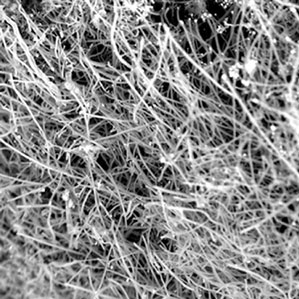Researcher Demonstrates How to Suck Carbon from the Air, Make Stuff from It
A new method for taking carbon dioxide directly from the air and converting it to oxygen and nanoscale fibers made of carbon could lead to an inexpensive way to make a valuable building material—and may even serve as a weapon against climate change.

Carbon fibers are increasingly being used as a structural material on the aerospace, automotive, and other industries, which value its strength and light weight. The useful attributes of carbon fibers, which also include electrical conductivity, are enhanced at the nanoscale, says Stuart Licht, a professor of chemistry at George Washington University. The problem is that it’s very expensive to make carbon fibers, much less nanofibers. Licht says his group’s newly demonstrated technology, which both captures the carbon dioxide from the air and employs an electrochemical process to convert it to carbon nanofibers and oxygen, is more efficient and potentially a lot cheaper than existing methods.
But it’s more than just a simpler, less expensive way of making a high-value product. It’s also a “means of storing and sequestering carbon dioxide in a useful manner, a stable manner, and in a compact manner,” says Licht. He points out that if the process is powered by renewable energy, the result is a net removal of carbon dioxide from the atmosphere. In a recent demonstration, his group used a unique concentrated solar power system, which makes use of infrared sunlight as well as visible light to generate the large amount of heat needed to run the desired reaction.
The process requires molten lithium carbonate, with another compound, lithium oxide, dissolved in it. The lithium oxide combines with carbon dioxide in the air, forming more lithium carbonate. When voltage is applied across two electrodes immersed in the molten carbonate, the resulting reaction produces oxygen, carbon (which deposits on one of the electrodes), and lithium oxide, which can be used to capture more carbon dioxide and start the process again.
The researchers demonstrated the ability to make a variety of different nanofiber shapes and diameters by adjusting specific growth conditions, such as the amount of current applied at specific points of time and the composition of the various ingredients used in the process. They also showed they could make very uniform fibers. Licht says the mechanisms underlying the formation of the fibers still need to be better understood, and he’s confident the group can keep developing more control over the nature of the fibers it makes.
As for the technology’s emissions-cutting potential, the researchers are optimistic. They calculate that given an area less than 10 percent of the size of the Sahara Desert, the method could remove enough carbon dioxide to make global atmospheric levels return to preindustrial levels within 10 years, even if we keep emitting the greenhouse gas at a high rate during that period.
Of course, this would require a huge increase in demand for carbon nanofibers. Licht believes the material’s properties, especially the fact that it is so lightweight and also very strong, will spur greater and greater use as the cost comes down, and he thinks his new process can help with that. Imagine that carbon fiber composites eventually replace steel, aluminum, and even concrete as a building material, he says. “At that point, there could be sufficient use of this that it’s actually acting as a significant repository of carbon.”
Deep Dive
Climate change and energy
The problem with plug-in hybrids? Their drivers.
Plug-in hybrids are often sold as a transition to EVs, but new data from Europe shows we’re still underestimating the emissions they produce.
Harvard has halted its long-planned atmospheric geoengineering experiment
The decision follows years of controversy and the departure of one of the program’s key researchers.
Why hydrogen is losing the race to power cleaner cars
Batteries are dominating zero-emissions vehicles, and the fuel has better uses elsewhere.
Decarbonizing production of energy is a quick win
Clean technologies, including carbon management platforms, enable the global energy industry to play a crucial role in the transition to net zero.
Stay connected
Get the latest updates from
MIT Technology Review
Discover special offers, top stories, upcoming events, and more.